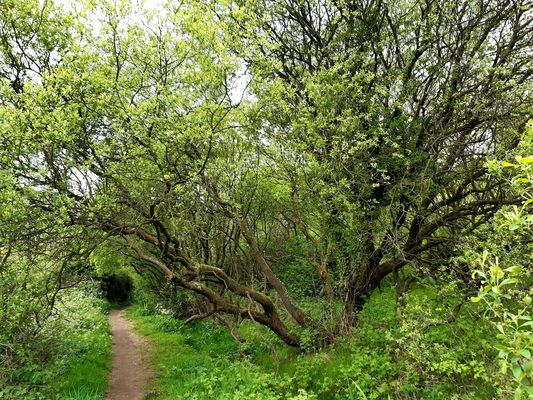It’s like an image from a fairytale – a wizened old willow overhanging an idyllic path which disappears intriguingly into a tunnel.
This hillside at Ligoniel is like being in an enchanting dream – a dream that stays with you long after you’ve woken. Dúlra has rarely experienced nature so perfectly. And this isn’t a famous setting like, say, the Mournes or the Glens of Antrim. This is just your average, bog-standard stretch of the Belfast hills. But allowed to grow naturally and opened up for the public, it’s simply magical.
Loneys like this used to run all over our hillsides. They were like mini-roads – bóithríní – that farmers and townsfolk could use to safely get into the country. They’ve all but disappeared, but small sections of these rural pathways still exist. Using loneys was a safe way to enjoy the hills – once you leave the city, most of the roads have no footpaths. You’re taking your life in your hands if you want to walk on, for example, the Upper Springfield Road. Loneys – if they could be salvaged – would give brilliant access to the countryside, with nature all around you as you travel.
With hedgerows on either side allowed to grow freely, they are wildlife havens. Dúlra has spent many hours watching bullfinches in the loney which used to run from Glen Road at Holy Spirit church to the Springfield Road. Only about 100 yards of it remains today – and it’s too overgrown to walk through. Wouldn’t it be great if it was saved for people in the city below to enjoy summer walks in?
Another great loney runs between abandoned cottages on Colin Mountain – again, it’s hard to access but in nature terms, worth the effort.
At Ligoniel a stream runs alongside this path – hence the wonderful, aged willow stretching its limbs. For willows to thrive they need to dip their roots directly into water – and this one has been allowed to grow unhindered.
Willows are rarely planted because they don’t grow the way we want them – upright and tall. Just like this one, they often refuse to have a main trunk at all, instead just branching out lazily to fill as much space as they are allowed.
When Dúlra was taking this picture the tree was alive with a flock of mixed tits picking insects off the leaves. With their constant chirps and tweets, it sounded like a family of fairies had appeared to complete the enchanted scene. Willows are packed with caterpillars and their early spring flowers are loved by bees. Ireland has six native varieties – you can be sure that this one which has been growing in a remote part of the Belfast hills for more than a century is one of them.
Ligoniel Dam is the hub of this park which has paths branching off like spokes into the wild hillside. This was once a dam for a massive linen mill – one of an incredible six in Ligoniel alone, which used water to run their turbines rather than steam which was used in other Belfast mills.
And as with nearby Carnmoney Hill above Rathcoole, houses here have been built so they are almost part of the dam and park – the opposite happens in West Belfast, where access to the mountain has always been prevented.
But, for Dúlra, it’s the willow tree that steals the show. With endless talk about planting so many millions of trees, there’s rarely any mention of protecting the ones that are already there. And right across the Belfast hills, you’ll find gems that are 100 years old and more. Yet they can be cut down for developments at any time.
The willow – saileach in Irish – is prized in Ireland because it was used to make harps. The most famous of them all – Brian Boru’s harp in Trinity College Dublin – is made entire from willow. That’s probably what helped the willow make the top 10 in the list of Irish trees drawn up way back in the seventh century.
Or maybe like Dúlra, the old druids just got swept away by its sheer magical beauty.
* If you’ve seen or photographed anything interesting or have any nature questions, you can text Dúlra on 07801 414804.







